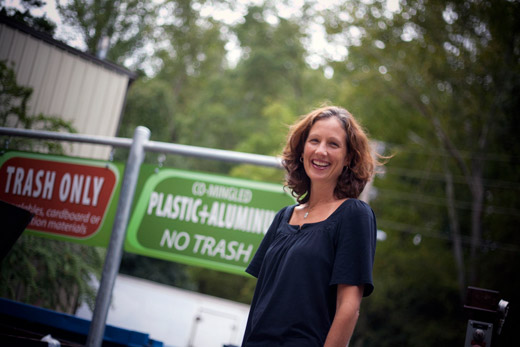People
September 14, 2011
Claire Wall: Keeping campus green

Claire Wall is administrative coordinator in Facilities Management.
By Margie Fishman
As the administrative program coordinator for Emory's roads and grounds, waste, recycling, shredding, staging and surplus teams, Claire Wall coordinates the yellow mums and ferns lining the stage for Commencement, maintains tree records, tracks the University's waste tonnage and even delivers slim jims (not the edible kind).
Wall, a 10-year Emory veteran, talks about creative ideas for waste, conscious consumption and the wackiest thing ever recycled on campus.
You wear many hats on campus. What are some of your responsibilities?
For the grounds shop, I provide support for the educational food gardens, small landscape enhancement projects and tree plantings, and design the annual flower beds for fall and spring plantings. I also keep records of the different tree species planted on campus by the Grounds department and help track our "No Net Loss of Forest Canopy" policy, which guarantees that every time a tree is removed enough trees will be planted to maintain the same forest canopy. For the recycling and shredding shops, some of my duties include updating the Emory Recycles website, tracking the University's progress toward its goal of diverting 65 percent of its waste by 2015 and helping with Earth Month events in April and National Recycling Week events during the fall.
How is Emory tracking toward its goal of reducing the University's total waste stream by 65 percent by 2015?
Emory Recycles keeps records of all the waste generated on campus. We track and record tonnage for all commodities recycled and composted which include aluminum, scrap metal, white paper, mixed paper, compost, glass, e-waste, batteries, demolition waste cardboard, food waste and animal bedding. We also track and record our non-recyclable waste tonnage from all the dumpsters on campus to calculate the total waste we send to the landfill. By keeping records of waste tonnage diverted from the landfill and waste tonnage landfilled, we can calculate the percentage of our waste diverted from the landfill every month in order to track our progress. Last fiscal year, 45 percent of Emory's total waste was recycled or diverted from the landfill. This fiscal year, we hope the expansion of our composting program and construction and demolition debris recycling program will help increase our diversion rate bringing us closer to our goal of 65 percent.
How did you become interested in working with recycling initiatives?
I graduated from Auburn University with a bachelor's degree in liberal arts and then worked at CNN Headline News as a video journalist. I got sick of working indoors in a windowless studio all day, so I started working at Color Burst, a landscape company specializing in annual plantings. I ended up taking an administrative assistant job at Emory under Exterior Services Director Jimmy Powell. All the shops in Exterior Services work closely together and we help each other out. After visiting the Recycling Center, I was amazed at the organized chaos. I thought the operation was something really special and immediately wanted to be a part of it.
What is the biggest challenge your department faces in persuading the campus community to recycle?
"People need to think about what happens to their 'stuff' once they get tired of it and replace it with the next best thing."
The Emory community knows how important it is to reduce waste and to recycle. I think we need to remind everyone to be more responsible in their purchases and to take just what they need. People need to think about what happens to their "stuff" once they get tired of it and replace it with the next best thing. It doesn't go away when you put it in the trash. It just goes somewhere else. Our biggest challenge is reaching out to the new freshman class each year and teaching them to be responsible and to reduce, reuse and recycle.
What has been your biggest accomplishment since joining Emory?
My favorite accomplishment was our Recycled Art Project (RAP), which we did for three years. RAP provided a showplace for artists who create art from found objects. RAP was a wonderful opportunity to get people thinking about how to reuse objects creatively and practically. I am also proud of our annual "Don't Dump It — Donate It" campaign held in May, where we collect unwanted items from the dorms and donate them to different charities. At times, it is an operational nightmare, but the appreciation from the charities we are able to help out is worth it. This year, we gave tons of donations to the tornado victims in Georgia, Alabama and Mississippi.
What is the strangest item someone on campus has tried to recycle?
The students always provide interesting items like dirty sheets and crazy costumes. At the Recycling Center on Peavine Creek Drive, people dump toilet seats, tires, couches, patio furniture — you name it. In 2003, we partnered with the National Recycling Coalition and Nike's national Reuse-a-Shoe program to collect used athletic shoes to be recycled into playground and gym surfaces. To this day, I still receive regular calls from people asking where they can bring their collection of dirty, smelly tennis shoes.
What activities do you enjoy outside of Emory?
I have a 3-year-old and a 15-month-old, so my hobby time is limited. When I am not at the playground, making macaroni and cheese or at the grocery store, I enjoy gardening, hiking throughout North Georgia and beyond, and playing the piano. Since I don't have time to learn new songs, I mostly play Christmas carols all year round. The kids seem to like it.
